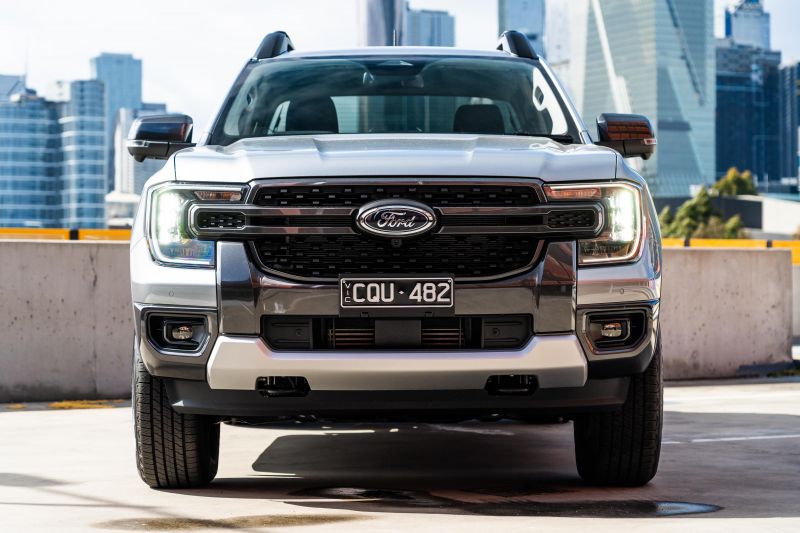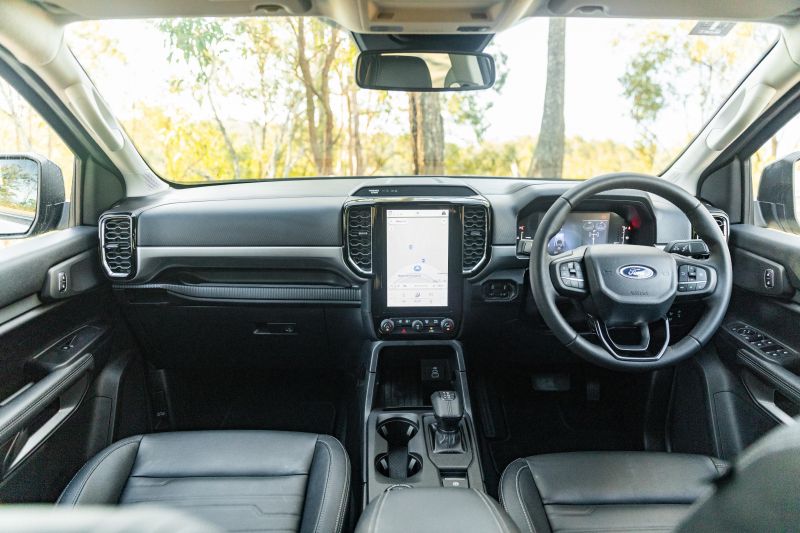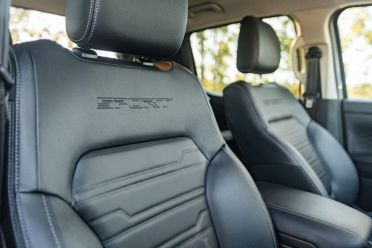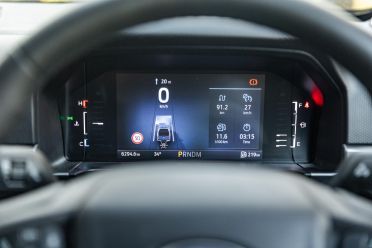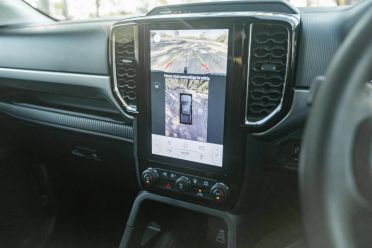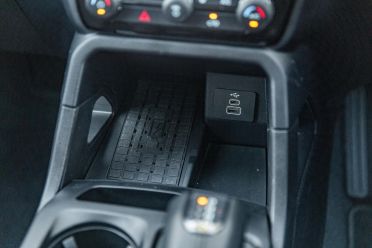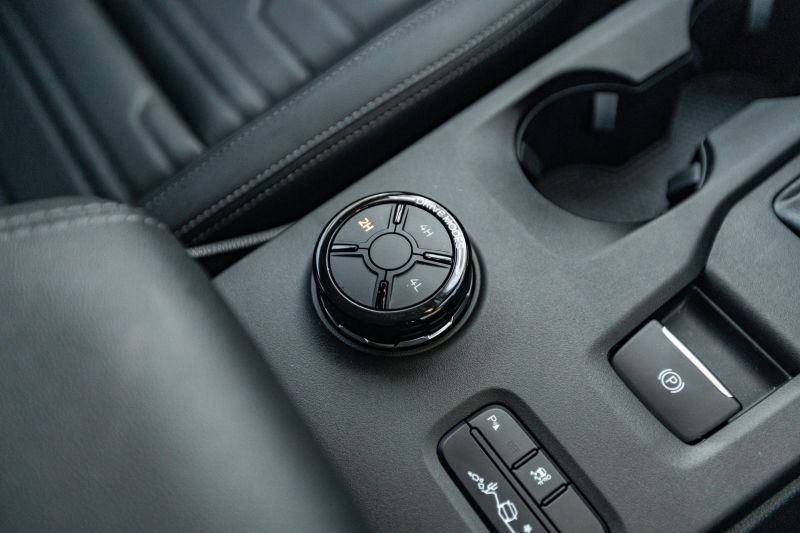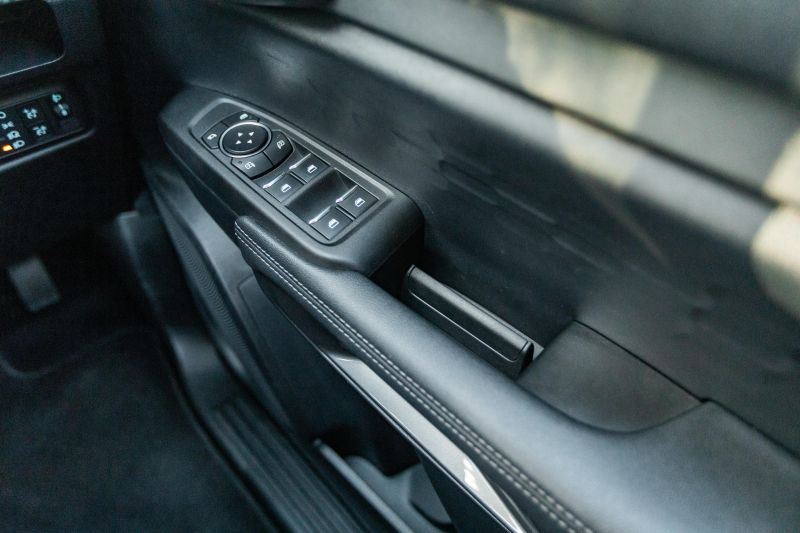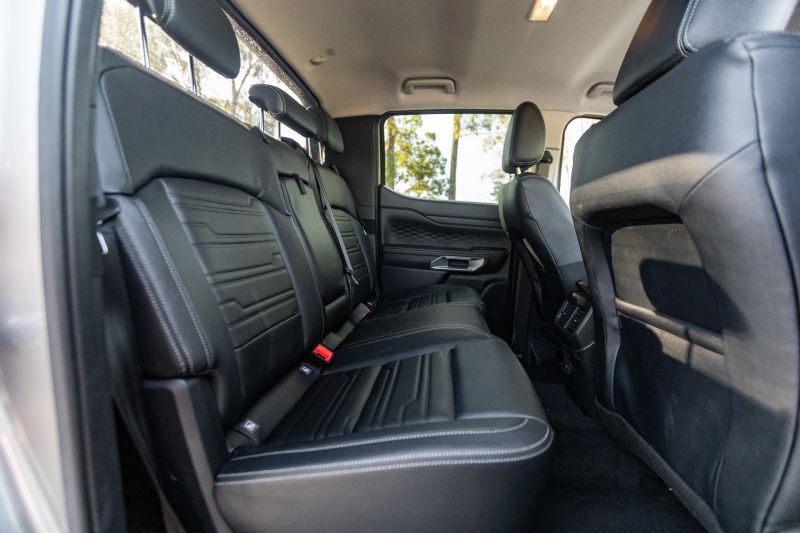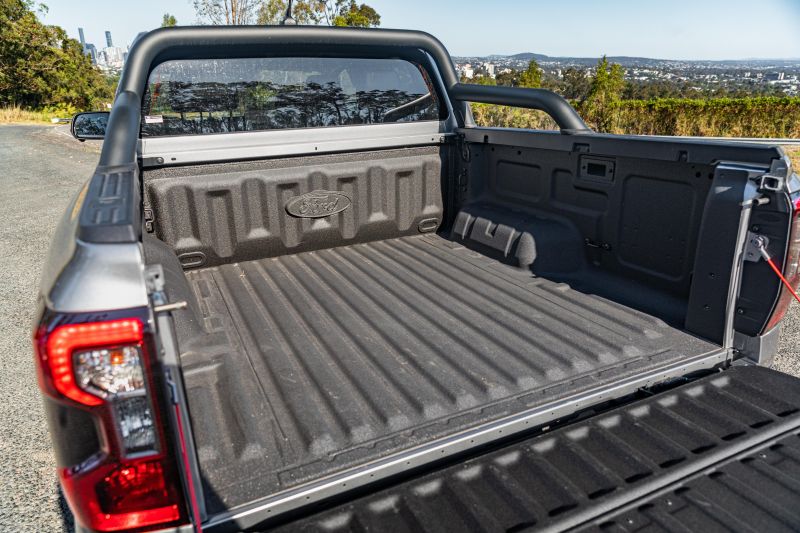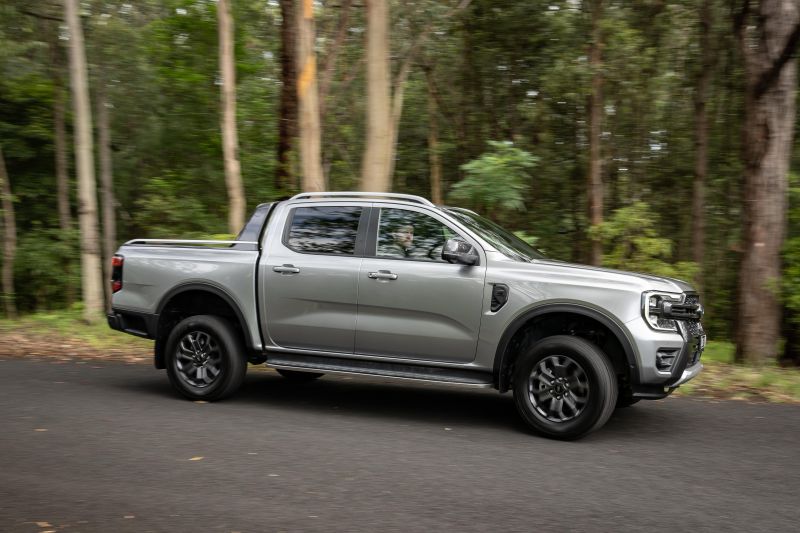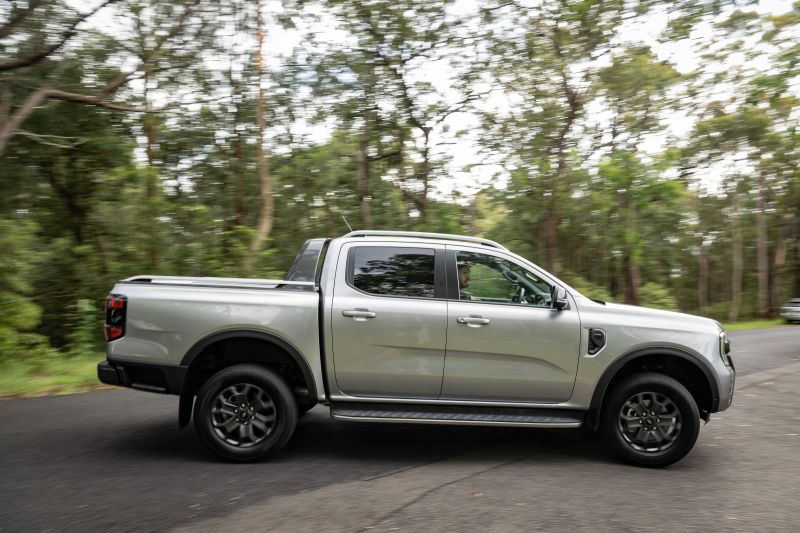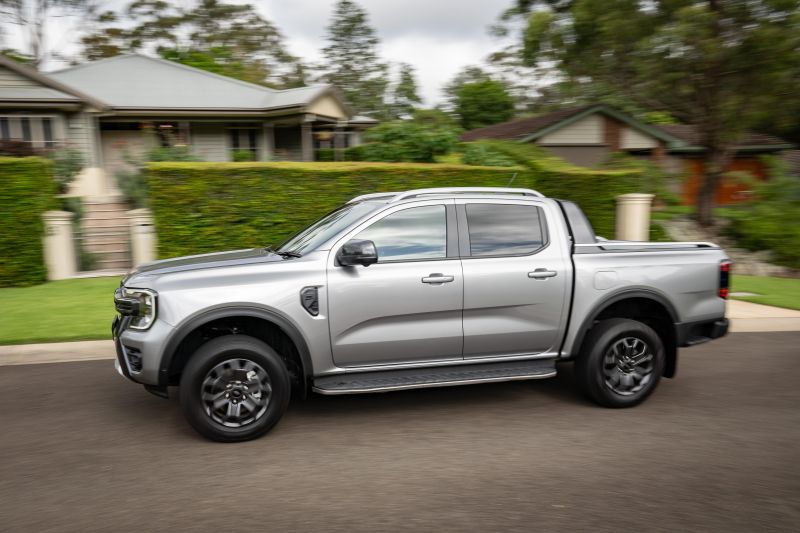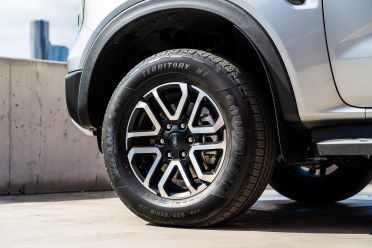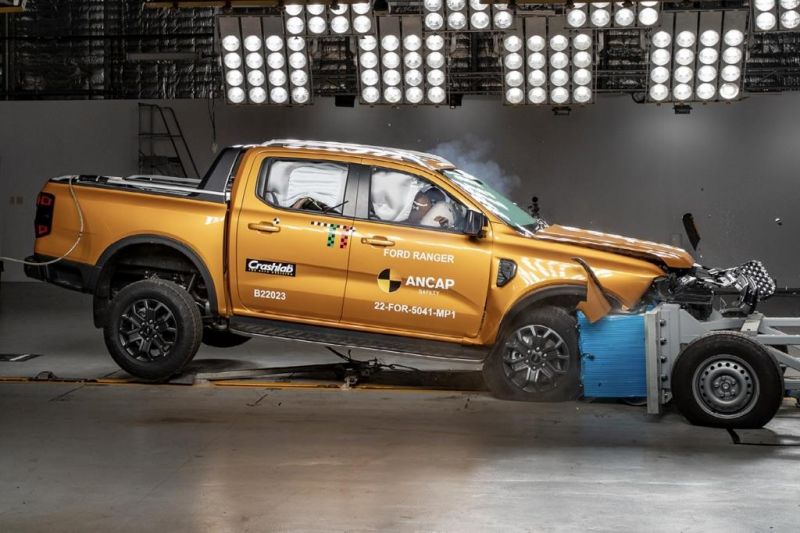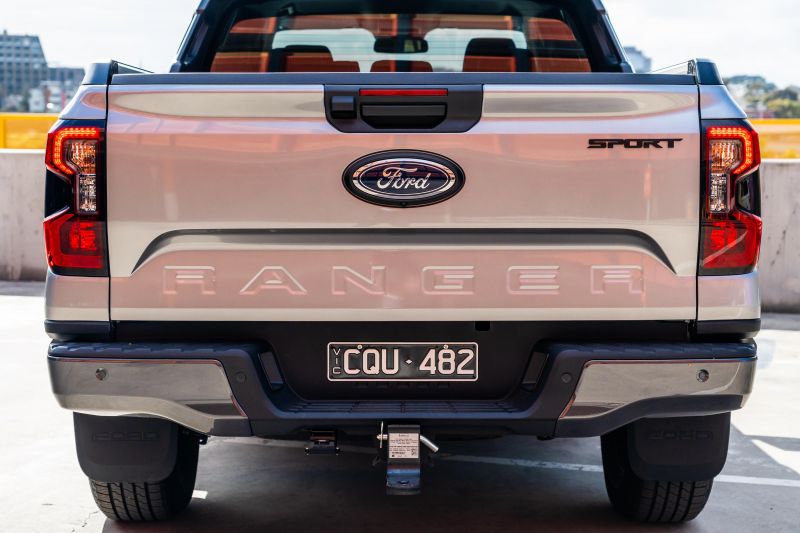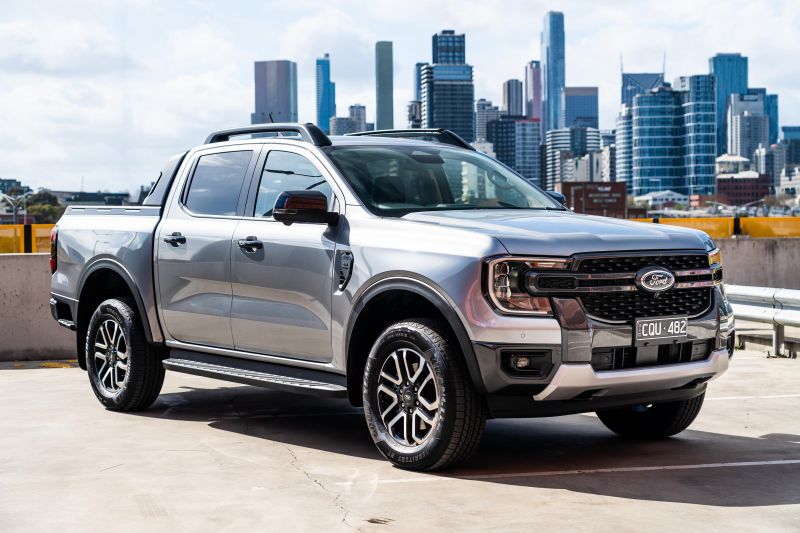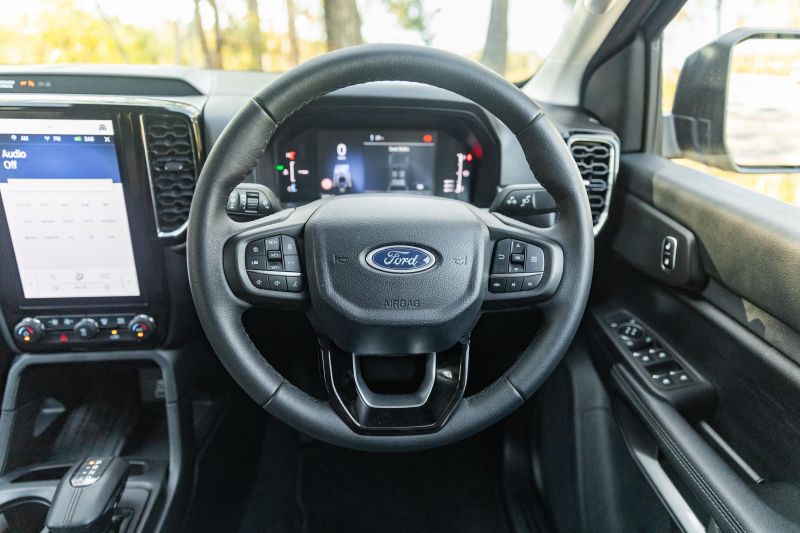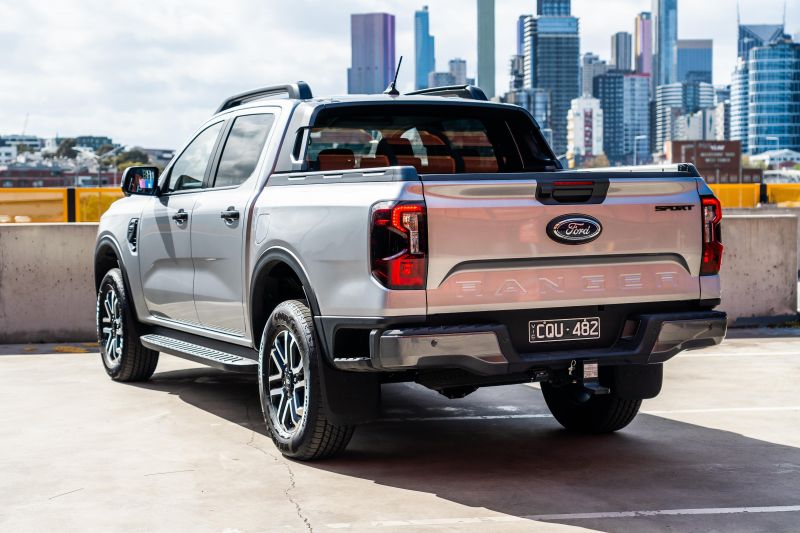The Ford Ranger has been Australia’s best-selling ute, and the nation’s most popular new vehicle overall, for the past two years. But the tide is beginning to turn.
For one, the Toyota RAV4 has been Australia’s best-selling vehicle for the past seven months straight, fell within 4000 sales behind the Ranger in 2024, and finished 400 units ahead last month.
Ford, meanwhile, lost third place in Australia’s overall monthly sales to Kia in February, when its overall sales were down 12.9 per cent on the same time last year. Light commercial sales were also down 10.2 per cent year-on-year.
Then there’s competition from other utes. While there are loads of new models either having just arrived or coming soon, the most threatening is the BYD Shark 6, which debuted in sixth overall in February – albeit roughly 2000 units behind the Ranger.
Its closest match continues to be the Toyota HiLux, which placed third in February with only 400 fewer sales than Ford’s alternative despite nearing the end of its life cycle, with a new model due next year.
And so the Ranger, while deserving of its segment-leading status, is burdened with the unenviable task of not only trying to stay ahead of the competition but also propping up overall Ford sales in Australia.
WATCH: Paul’s video review of the 2023 Ford Ranger Wildtrak bi-turbo
With 62,593 sales in 2024, the Ranger recorded more than double the deliveries of its closest stablemate in the form of the Ranger-based Everest, which was Australia’s top-selling large SUV with 26,494 sales. The remainder of Ford’s lineup struggled to crack even the 4000-unit mark.
Putting more eggs in the comprehensive Ranger basket, Ford will soon bolster its ute offerings with the hardcore Super Duty and a long-awaited plug-in hybrid (PHEV) powertrain to fend off the Shark 6, as well as the GWM Cannon Alpha PHEV, but it ill be much dearer than both.
In the meantime, here we’re testing one of the most desirable variants in the Blue Oval’s enormous ute lineup – the Ford Ranger Sport V6 – which is also one of the cheapest equipped with the lusty six-cylinder turbo-diesel. But it still costs more than $70,000 before on-road costs, so is it the one to go for?
How does the Ford Ranger compare?
View a detailed breakdown of the Ford Ranger against similarly sized vehicles.

Ford
Ranger
How much does the Ford Ranger cost?
Priced at $71,340 before on-roads, the Sport V6 sits near the top of the diesel-powered Ranger dual-cab lineup, positioned above the four-cylinder Sport ($66,140 before on-roads) and the XLT V6 ($66,840 before on-roads), but below the Wildtrak V6 ($74,840 plus on-roads) and the Platinum V6 ($80,640 before on-roads).
Ranger XL
| Model | Price before on-roads |
|---|---|
| 2025 Ford Ranger XL 4×2 single-cab/chassis | $36,880 |
| 2025 Ford Ranger XL 4×2 Super-cab/chassis | $39,380 |
| 2025 Ford Ranger XL 4×2 double-cab pickup | $43,280 |
| 2025 Ford Ranger XL 4×4 bi-turbo single cab/chassis | $47,980 |
| 2025 Ford Ranger XL 4×4 double-cab/chassis | $48,980 |
| 2025 Ford Ranger XL 4×4 bi-turbo Super-cab/chassis | $50,480 |
| 2025 Ford Ranger XL 4×4 double-cab pickup | $50,880 |
| 2025 Ford Ranger XL 4×4 bi-turbo double-cab/chassis | $52,480 |
| 2025 Ford Ranger XL 4×4 bi-turbo double-cab pickup | $54,380 |
Ranger XLS
| Model | Price before on-roads |
|---|---|
| 2025 Ford Ranger XLS 4×4 bi-turbo double-cab pickup | $57,630 |
Ranger XLT
| Model | Price before on-roads |
|---|---|
| 2025 Ford Ranger XLT 4×2 bi-turbo double-cab pickup | $56,440 |
| 2025 Ford Ranger XLT 4×4 bi-turbo Super-cab pickup | $61,640 |
| 2025 Ford Ranger XLT 4×4 bi-turbo double-cab pickup | $63,640 |
| 2025 Ford Ranger XLT 4×4 V6 double-cab/chassis | $66,940 |
| 2025 Ford Ranger XLT 4×4 V6 double-cab pickup | $68,840 |
| 2025 Ford Ranger XLT 4×4 PHEV double-cab pickup | $71,990 |
Ranger Sport
| Model | Price before on-roads |
|---|---|
| 2025 Ford Ranger Sport 4×4 bi-turbo double-cab pickup | $66,140 |
| 2025 Ford Ranger Sport 4×4 V6 double-cab pickup | $71,340 |
| 2025 Ford Ranger Sport 4×4 PHEV double-cab pickup | $75,990 |
Ranger Wildtrak
| Model | Price before on-roads |
|---|---|
| 2025 Ford Ranger Wildtrak 4×4 bi-turbo double-cab pickup | $69,640 |
| 2025 Ford Ranger Wildtrak 4×4 V6 double-cab pickup | $74,840 |
| 2025 Ford Ranger Wildtrak 4×4 PHEV double-cab pickup | $79,990 |
Ranger Platinum
| Model | Price before on-roads |
|---|---|
| 2025 Ford Ranger Platinum 4×4 V6 double-cab pickup | $80,640 |
Ranger Stormtrak
| Model | Price before on-roads |
|---|---|
| 2025 Ford Ranger Stormtrak 4×4 PHEV double-cab pickup | $86,990 |
Ranger Raptor
| Model | Price before on-roads |
|---|---|
| 2025 Ford Ranger Raptor 4×4 3.0TT V6 double-cab pickup | $90,440 |
To see how the Ford Ranger stacks up against its rivals, use our comparison tool
What is the Ford Ranger like on the inside?
Easily among the best-presented in its segment and comfortable enough to keep you happy.
First up, those with a keen eye will notice all Rangers up to and including the Sport get a 10.1-inch vertical touchscreen, which is smaller than what’s found in the Wildtrak and up.
If you’re coming from a Wildtrak down to the Sport you’ll certainly see the difference, but in isolation there’s nothing wrong with this smaller unit and it’s still larger than what a lot of the competition offers. The screen is sharp, but once you’re past the thick black bezels, your next task is to figure out how it all works.
It’s not immediately obvious where to go or what to press. But after a bit of poking and prodding you’ll eventually find the vehicle settings shortcut at the top right, which is your access to all of the car’s key functions.
It’s where you’ll adjust many of the ute’s safety features and many other functions, including connecting a smartphone. This is done via either wireless Apple CarPlay and Android Auto, which are standard across the Ranger family.
To its credit, the wireless CarPlay worked flawlessly in our week with the ute, and interacting with its interface on-screen was consistently snappy. We do wish full-screen integration was standard instead of sharing the space with a climate panel, but it’s still clean as a whole.
The screen’s native user interface can also toggle between light and dark modes depending on exterior light levels, though we found light mode to be particularly jarring against Apple CarPlay. Fortunately, you can lock it in dark mode through the vehicle settings menu.
This will adjust the hotbar at the top of the screen, which houses the vehicle settings, app menu shortcut, and basic info, as well as the climate screen down at the bottom.
We don’t mind the always-on approach to a panel like this, but it seems especially thoughtful here given there are physical controls fitted as well. It’s a decent way to visualise the various climate settings while maintaining the handy functionality of actual buttons and knobs for use on the move.
It’ll continue to show when the exterior cameras are engaged and in other apps too, like the Tesla-esque sketchpad fitted as a bit of a novelty. All up, the display makes sense once you’ve had some time to get used to it all, and its modern aesthetic is an attractive interior centrepiece.
Below it is an interesting arrangement of plastic trim, though the ‘handles’ on either side aren’t quite as sturdy as we’d like.
Below, there’s a cubby where a wireless charging pad and individual USB-A and USB-C ports are located. It’s about as simple as it gets, and we like how the charger’s rubber surface keeps phones firmly in place – not to mention appropriately aired-out to keep things cool while charging.
Further back is a slot to keep keys and phones out of the way, as well as two cupholders with spring-loaded teeth. They’re nicely sized for larger cups and bottles and connected by a large cut-out for extra versatility.
Also here is the three-way drive mode selector and a few simple buttons for off-road controls. What features prominently across all these high-touch areas is rough, dull plastic, which should be incredibly hard-wearing and ideal for higher-impact use cases.
Then there’s the chunky gear selector. With its simple up-or-down motion there’s not much to play with here, but there are manual shift buttons on the side of the gearknob, which can be used in Sport mode but are easy to push inadvertently.
Still, everything here is built around functionality and is designed to stand up to abuse. The most significant piece of glossy plastic is found around the infotainment display, but we’re glad the buttons fitted here maintain a dull finish.
Moving to the instrument display reveals a smaller unit than you may expect. At 8.0 inches, it’s reminiscent of something you’d find in an Isuzu D-Max, thanks mostly to the temperature and fuel meters flanking the screen.
It’s functional though, and offers enough configurability to find the screen layout you like best. Its digital portion is clean and legible, while scrolling through the different available layouts will reveal loads of information – or just the important bits like rev counts and speedos.
Our only real complaint is that its resolution isn’t quite as sharp as we’d like. That’s offset when you remember every Ranger up to the Wildtrak has the same screen, and it’s only when you get to the much more expensive Platinum that you get the larger 12.4-inch unit.
In front of it is the steering wheel, which – disappointingly – isn’t leather-wrapped in the Sport. It still feels fine in the hands and doesn’t look cheap, and its size is appropriate for a ute like the Ranger.
We do think buyers deserve a leather-wrapped wheel when paying more than $70,000, but if you want one you’ll have to fork out for the Platinum instead.
You at least get “leather-accented” upholstery, which Ford describes as a combination of real and synthetic leather. There are nice “Sport” engravings on the front seats to differentiate it from other models, though the Sport does miss out on seat heating and ventilation functions.
There’s still powered driver’s seat adjustment as standard. That helps to get comfortable with help from a good degree of adjustment from the steering wheel, while all the key touch points are soft enough for relaxed driving positions.
Tucked away in the armrests are the Ranger’s internal door handles. It’s a tidy solution to a problem that didn’t really exist, but they can provide a moment of entertainment when passengers try to find them.
Storage options are adequate, though not as diverse as in some of the other Rangers. A notable omission is the Wildtrak’s pop-out cupholders – a unique feature for the ultimate tradie-mobile.
Otherwise, you get a decently sized central box, a standard glovebox with a small nook above, and bottle holders in the door cards.
Stepping into the Ranger Sport is made easier through the inclusion of side steps as standard, and there are handles on the A- and B-pillars to pull yourself in. Once you’re in the second row, you’ll find there’s a decent amount of space around.
Rear headroom is good thanks to the high roof, though legroom will depend on where the front seats are positioned. With the driver’s seat in my average-height position, I had no issues sitting behind.
The seats here are flat but still comfortable enough, and they’re upholstered in the same leather-accented trim as found in the front. Space with all three seats in use does become cramped, especially because middle passengers will have to contend with a sizeable driveline hump on the floor, as per other utes.
There’s a fold-down centre rear armrest with cupholders, plus a single 12V outlet and dual air vents on the back of the centre console, though there’s no dedicated climate control panel.
Otherwise, rear passengers get map pockets on the front seatbacks and bottle holders in the doors. It’s a perfectly useable space, just nothing too special.
Out the back is a sizeable tub that’s still one of the best in the business. You get a bed liner as standard, and it’s a perfectly square area bar the small indents created by the wheel-arches.
There are metal cargo anchor points fitted in each corner, but otherwise it’s a case of what you see is what you get. While standard Ranger Sports are fitted with a metal sports bar, our tester featured Ford’s optional Flexible Rack System.
Typically a $2800 extra, the rack features a sleek sailplane that can slide into various positions atop the bed, creating a solid option for securing long items to the roof that otherwise wouldn’t fit.
It adds another level of practicality to the Sport, and it’s a worthwhile inclusion if you can spring for the increased cost. New Rangers will now also be available with 400W outlets in the bed, and an “interior console” not seen in our tester.
| Dimensions | Ford Ranger Sport V6 |
|---|---|
| Length | 5370mm |
| Width | 1918mm |
| Height | 1886mm |
| Wheelbase | 3270mm |
| Tray length | 1464mm |
| Tray width | 1520mm |
| Tray depth | 525mm |
To see how the Ford Ranger stacks up against its rivals, use our comparison tool
What’s under the bonnet?
There are now four powertrains available across the Ranger lineup, though one is reserved for the beefy Raptor flagship. While the Sport can also be had with four-cylinder bi-turbo diesel and PHEV powertrains, our tester was fitted with Ford’s 3.0-litre turbo-diesel V6.
| Specifications | Ford Ranger Sport V6 |
|---|---|
| Engine | 3.0L turbo-diesel V6 |
| Power | 184kW @ 3250rpm |
| Torque | 600Nm @ 1750-2250rpm |
| Transmission | 10-speed automatic transmission |
| Drive type | Full-time 4WD |
| Fuel economy (claimed) | 8.4L/100km |
| Fuel economy (as tested) | 9.9L/100km |
| CO2 emissions (claimed) | 222g/km |
| Fuel tank | 80L |
| Kerb weight | 2346kg |
| Payload | 934kg |
| Braked towing capacity | 3500kg |
| Gross vehicle mass (GVM) | 3280kg |
| Gross combination mass (GCM) | 6400kg |
Our week with the Ranger primarily involved freeway driving, yet our fuel figure was noticeably thirstier than Ford’s claim, although it was still under 10.0L/100km.
To see how the Ford Ranger stacks up against its rivals, use our comparison tool
How does the Ford Ranger drive?
Once you’re out on the road, it’s easy to see why the Ranger is as popular as it is.
-
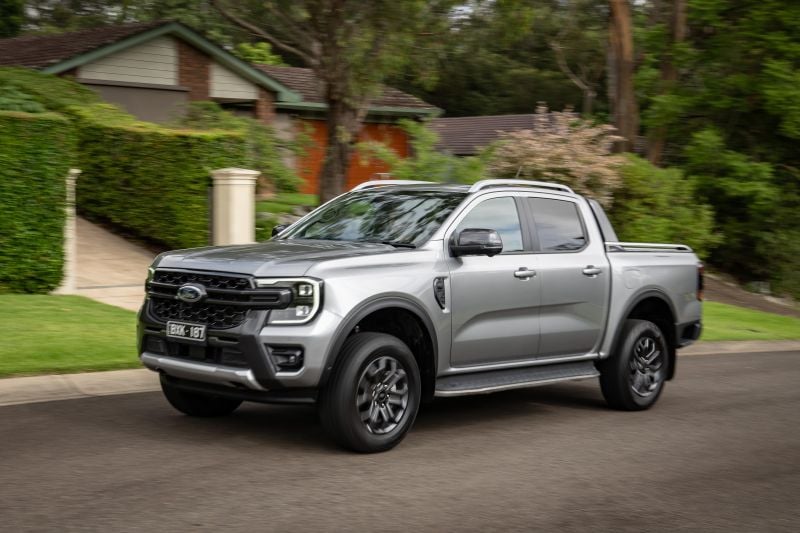
Ford Ranger Wildtrak shown
What’s under the bonnet is the big thing separating one Ranger from the next, and the V6 in our tester is, without a doubt, the preferable option.
Its strength is in its smoothness. Having an extra two cylinders over the bi-turbo does wonders to iron out the coarse nature of most diesels, to the point where it almost doesn’t feel like a diesel engine at all.
Throttle response is also snappy, and that full 600Nm of torque is nothing to sneeze at when it’s almost always on tap. So much so that we found the rear-end of the Sport to be particularly loose, even without the optional all-terrain tyres fitted.
Adopt a heavy right foot around a tight turn and you’ll feel the rear attempt to step out before the stability control kicks seamlessly in. That’s most obvious unladen on a wet road, and although there’s a lot more traction in the dry or when laden, Ranger V6s feel more taily than many other utes.
Of course, that’s only when driving in rear-wheel drive, and everything is well anchored with all four wheels engaged.
In normal driving, the Ranger exhibits SUV-like refinement. This is evident in its level of cabin refinement, as road noise is kept to a minimum, though you will hear some wind noise when travelling at higher speeds.
Ford has also done well to iron out some of the ride quality quirks that afflict most utes. You won’t notice quite as much bouncing or clattering as you would in some of the competition, which is especially impressive when unladen.
Throwing some cargo in the tub smooths things out even more, though a load isn’t required for a comfortable ride. It’s therefore more than capable as a daily commuter while still being practical enough for the weekend warrior and handyman.
However, the Sport does lose some of the Ranger’s hardy tradesman appeal.
It’s too nice for commercial abuse on a regular basis, which is why you see so many of them in the carparks of urban office buildings. Its no less capable than any other dual-cab, but be prepared for potential interior damage or paint scratches if you’re putting a ute like the Ranger Sport to work.
In terms of handling, the Ranger Sport is surprisingly composed. You do lose some on-road finesse with all-terrain tyres fitted, but you won’t notice too many complaints from the front-end around turns.
Its suspension is soft enough to be comfortable without compromising body control and, though it’d be unfair to expect racecar-like cornering ability from a ute, the Ranger is still the benchmark in terms of ride/handling compromise.
The steering feel is nicely weighted, with enough feedback to give you a clear idea of what you’re driving over.
Visibility out of the Ranger is also good. Its seating position is fairly high, which allows you to look out over the expansive bonnet and a lot of other traffic on the road.
Its side windows are large enough for easy headchecks, while the tub doesn’t get in the way of the view out the rear window. And if objects are obscured, there’s a wide array of sensors and cameras to assist you – the surround-view camera included in the $1650 optional Touring Pack is especially useful when parking.
The same can’t be said for all of the Ranger’s safety gear though, as there were a few quirks that popped up while on the move.
One we’ve experienced before in other Fords is an issue with the lane-keep system. If you’re travelling for extended periods on straight pieces of freeway, the car will prompt you to keep your hands on the steering wheel – even if you never took them off.
It’ll throw the same warning if you stray too close to the lane markings, which means it can be confusing to know what you’re actually doing wrong when it pops up out of the blue.
At least there are no issues with the driver monitoring system, and there’s nothing else to beep at you while you’re motoring along.
We appreciate the smooth operation of adaptive cruise control and lane-centring, which work well enough to be relied upon during longer drives.
It’s still worth paying attention as the ute tends to occasionally veer towards the lane’s edge, but it’s not bad enough to consider it an issue and it reacts well to slight steering inputs from the driver.
All up, the Sport delivers an impressive driving experience. We like the Ranger’s on-road maturity, bolstered by its smooth ride quality and competent handling – not to mention how well it’s all put together.
Its seats are comfortable and adjustable, while the high seating position is ideal for a ute of this size. The large side mirrors mean you won’t miss what’s going on around, and there are those sensors to help you out if need be.
The V6 is certainly is the pick of the Ranger’s two diesel engines thanks to its smoothness and power. That could change when the PHEV arrives, but for now we’d much rather have this than the also-strong bi-turbo four.
For a full breakdown of the Ranger’s off-road capabilities, watch Paul’s video test below.
| Off-road dimensions | Ford Ranger Sport V6 |
|---|---|
| Track front and rear | 1620mm |
| Ground clearance | 234mm |
| Approach angle | 30 degrees |
| Departure angle | 23 degrees |
| Ramp breakover angle | 21 degrees |
| Wading depth | 800mm |
To see how the Ford Ranger stacks up against its rivals, use our comparison tool
What do you get?
The Sport sits in the middle of the eight-grade Ranger lineup.
2025 Ford Ranger XL equipment highlights:
- Acoustic windscreen
- 16-inch steel wheels
- All-season tyres
- 16-inch steel spare wheel
- Front disc and rear drum brakes
- Heavy-duty suspension
- Black grille
- Halogen headlights
- Halogen daytime running lights
- LED central high-mounted tail light
- LED tail-lights (pickup only)
- Tailgate with lift assist (pickup only)
- Integrated tailgate step (pickup only)
- 10.1-inch Sync4 portrait touchscreen infotainment system
- Wireless Apple CarPlay and Android Auto
- Embedded modem
- Remote start via FordPass app
- 8.0-inch digital instrument cluster
- Tilt and telescopic steering column adjustment
- Ebony cloth upholstery
- Eight-way manual driver seat
- Four-way manual front passenger seat
- Vinyl floor covering
- Power rear windows (double cab only)
- Single-zone climate control
- Electronically locking rear differential (4×4 models only)
- Conventional gear selector
- Mechanical handbrake
XLS adds:
- 400-Watt power inverter
- 16-inch Dark Sparkle Silver alloy wheels
- Black side steps
- Halogen front fog lights
- Black grille with silver accents
- Carpet flooring
- Driver floor mat
- Drive mode selection
- Tow bar
- Trailer light check
- Integrated trailer brake controller
- Body-colour door handles
- Six-speaker sound system
- Proximity entry with push-button start
- Dual-zone climate control
- Rear seat air vents
- Satellite navigation
- DAB+ digital radio
XLT adds:
- 17-inch Dark Sparkle Silver alloy wheels
- 17-inch steel spare wheel
- Rear disc brakes
- Electronic handbrake
- Leather-wrapped ‘e-Shifter’ gear selector
- 4×2 locking rear axle
- Front grille with chrome central bar
- LED headlights
- C-shaped LED daytime running lights
- Front-mounted tow hook
- Black sports bar (pickup only)
- Rear tub illumination (pickup only)
- Bedliner with 12V socket (pickup only)
- Spray-in bedliner with 12V socket (super cab only)
- Electrochromatic mirror
- Rain-sensing wipers
Note: Acoustic windscreen is not featured on XLT and above.
Sport adds:
- 18-inch machine-faced and Asphalt Black accent alloy wheels
- 18-inch spare wheel
- Dark accent grille
- Dark exterior accents
- Two front-mounted tow hooks
- Skid plate
- Front floor mats
- Rotary drive mode selector
- Wireless phone charging
- Off-road screen
- Ebony leather upholstery with ‘SPORT’ embossing
- Eight-way power-adjustable driver seat
- Six-way manual front passenger seat
Our tester featured the optional Flexible Rack System ($2800).
Is the Ford Ranger safe?
All variants of the 2024 Ford Ranger lineup, apart from the flagship Raptor, have a five-star ANCAP safety rating.
| Category | Ford Ranger |
|---|---|
| Adult occupant protection | 32.24 out of 38 (84 per cent) |
| Child occupant protection | 46.00 out of 49 (93 per cent) |
| Vulnerable road user protection | 39.96 out of 54 (74 per cent) |
| Safety assist | 13.39 out of 16 (83 per cent) |
Standard safety equipment includes:
- 9 airbags
- incl. driver, passenger knee airbags
- incl. front-centre airbag
- Autonomous emergency braking (AEB)
- Car, pedestrian, cyclist detection
- Junction assist
- Adaptive cruise control
- Blind-spot assist
- Rear cross-traffic alert (pickup)
- Lane departure warning
- Lane-keep assist
- Reversing camera (pickup)
- Rear parking sensors (pickup)
- Trailer Coverage (with optional Tow Pack)
Ranger XLS adds:
- Front parking sensors
- Extended blind-spot monitoring with trailer coverage
Ranger XLT adds:
- Adaptive cruise control incl. stop/go
- Blind-spot monitoring incl. Trailer Coverage
- Lane-centring assist
- Traffic sign recognition
- Tyre pressure monitoring
The optional Touring Pack ($1650) adds a surround-view camera.
How much does the Ford Ranger cost to run?
The 2025 Ford Ranger is covered by a five-year, unlimited-kilometre warranty, like the rest of the Ford range.
| Servicing and Warranty | Ford Ranger |
|---|---|
| Warranty | 5 years, unlimited kilometres |
| Roadside assistance | 12 months complimentary, then service-activated |
| Service intervals | 12 months, 15,000km |
| Capped-price servicing | 4 years, 60,000km – $379 each |
| Total capped-price service cost | $1516 |
Compared to its rivals, servicing costs are competitive. The Toyota HiLux is covered by the same warranty and three years of capped-price servicing, totalling up to $1740 – though it has shorter six-month, 10,000km intervals.
The D-Max, meanwhile, is backed by a six-year, 150,000km warranty and five years of capped-price servicing. Maintenance is required every 12 months or 15,000km, and each service costs $469 for a total of $2345 over five years.
Though not directly comparable, the BYD Shark 6 is covered by a six-year, 150,000km warranty. Servicing is required every 12 months or 20,000km, and costs a total of $2489 over five years.
To see how the Ford Ranger stacks up against its rivals, use our comparison tool.
CarExpert’s Take on the Ford Ranger
The Ford Ranger remains the benchmark in Australia’s dual-cab ute segment, and the Sport is one of the finest examples.
It looks the part and feels fairly premium inside, with quality materials and intuitive tech. There are still some reminders this is a jack-of-all-trades ute, but a lot of its utilitarianess has been filtered out to create a vehicle that feels much more like a passenger car.
While it’s impressive that Ford Australia has managed to create such a classy feeling commercial vehicle, the Sport occupies a weird space in the Ranger lineup and won’t be for everyone. Do you go for a Ranger that’s cheaper and harder-wearing but a bit less comfortable, or pay a bit more to go further into the SUV-with-a-tub lifestyle?
There are options to go both ways. The Ranger XLT is also available with all three standard powertrains (including PHEV), offers most of the important features, and is a little cheaper, better geared towards work and feels less afraid to get dirty.
Conversely, the Wildtrak isn’t that big of a step up price-wise when you consider the extra gear you get.
The Sport is certainly a great ute that drives well and nails the criteria for a so-called lifestyle ute, arguably better so than any of its competition, which it easily outdoes in terms of refinement, capability and suitability, both on- and off-road.
That said, we think spending a bit of time weighing up what it is you actually need from your ute will probably land you on either the XLT or Wildtrak instead – and you really won’t lose out by going for one of those instead.
The electrified petrol Shark 6 and soon the Cannon Alpha and the Ranger itself will certainly upset the status quo when it comes to diesel-powered utes, but a lot of Australians will still want a Ranger just as it is, and right now the V6 diesel is still the engine to go for.
Interested in buying a Ford Ranger? Get in touch with one of CarExpert’s trusted dealers here
Click the images for the full gallery
MORE: Everything Ford Ranger



